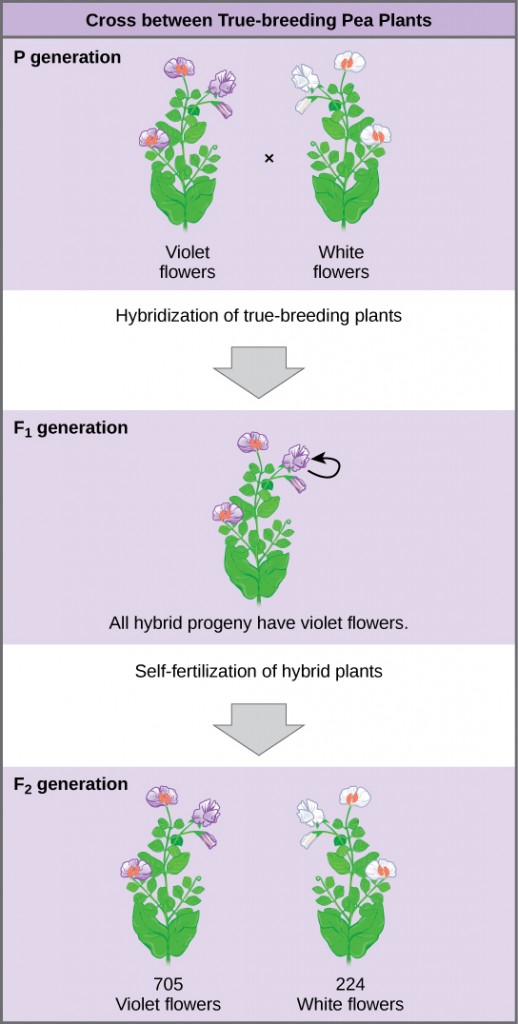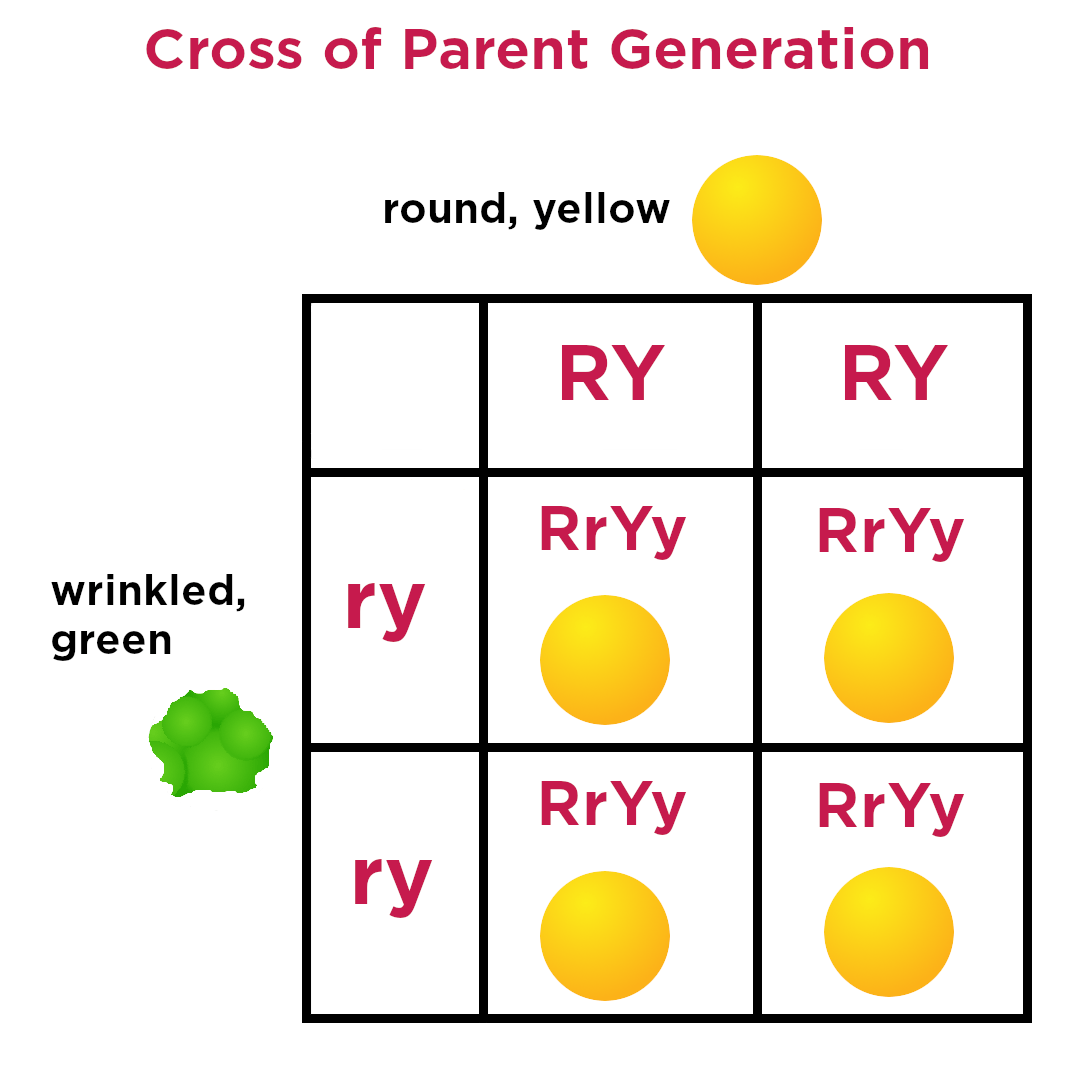Mendel’s Experiments Study Guide
Mendel’s Laws of Inheritance
The Gregor Mendel pea plant experiment was conducted between 1856 and 1863. Mendel selected several specific pea traits and performed cross-pollination or artificial pollination in pea lines with stable trait inheritance that were continuously self-pollinating.
Why was Pea Plant Selected for Mendel’s Experiments?
- The pea plant is simple to grow and maintain.
- They are self-pollinating by nature, but they may also be cross-pollinated.
- Because it is an annual plant, multiple generations may be examined in a short amount of time.
- Some peas were round and some were wrinkled. Why? This was a question Mendel wanted to answer.
Mendel used a pea plant as a test subject and looked for seven distinct features in the plants. Then he carried out both tests to figure out the inheritance laws mentioned above.
To discover the rules of heredity, Mendel undertook two major experiments. These were the experiments:
- Monohybrid cross
- Dihybrid cross
Monohybrid Cross

In this experiment, Mendel mated two pure breeding (self-pollinating) pea plants with opposing qualities (one short and one tall). He did this by manually transferring the pollen from one type of pea plant to the other type. The first generation cross was termed P plants (parental). He named the first generation offspring F1 progeny because they were tall. He let the F1 generation self fertilize, and noticed that the F2 generation had BOTH tall and short plants in a ratio of 3:1! This was unlike the F1 generation where all the plants were tall.
Mendel repeated the experiment with additional opposing features, such as green vs. yellow peas, round vs. wrinkled peas, and so on. He discovered that the outcomes were consistent in all of the situations. He developed the rules of segregation and dominance as a result of this.

Dihybrid Cross
In the first experiment, Mendel only experimented with one trait – tall vs short. In the dihybrid cross experiment, Mendel evaluated two distinct traits – color AND seed shape. When he mixed wrinkled-green seeds with round-yellow seeds, he discovered that 100% of the F1 offspring were round-yellow. This meant that the circular form and yellow color were the most prominent features. He soon came to identify these as dominant traits.

He then self-pollinated the F1 progeny and acquired four distinct characteristics in the ratio 9:3:3:1: wrinkled-yellow, round-yellow, wrinkled-green seeds, and round-green.
Conclusions from Mendel’s Experiments
- The genotype refers to the plant’s genetic makeup, and the phenotype, on the other hand, refers to the plant’s physical appearance.
- Alleles are pairs of genes that are passed down from parents to children, and code for specific traits like tall/short, yellow/green
- When the chromosomes are half during gametogenesis, one of the two alleles has a 50% probability of fusing with the other parent.
- Homozygous alleles are those with the same alleles, whereas heterozygous alleles are those with different alleles.
Mendel’s laws
1. Law of Dominance
According to the law of dominance, hybrid children will only acquire the dominant characteristic in the phenotypic. The repressed alleles are recessive traits, whereas the alleles that define the characters are referred to as dormant traits.
2. Law of Segregation According to the segregation rule, each individual has two alleles, and only one allele is handed down to the children.
3. Law of Independent Assortment
According to the law of independent assortment, the inheritance of one pair of genes is unrelated to the inheritance of another pair.
Conclusion:
-
The process through which a kid inherits genetic information from a parent is known as inheritance.
-
Mendel used a pea plant as a test subject and looked for seven distinct features in the plants. Then he carried out both tests to figure out the aforementioned inheritance laws.
-
To discover the rules of heredity, Mendel undertook two major experiments. These were the experiments:
→ Monohybrid cross
→ Dihybrid cross
-
From the above two experiments, Mendel formulated three laws of inheritance:
→ Law of Dominance
→ Law of Segregation
→ Law of Independent Assortment
FAQs:
1. What was Mendel’s famous experiment?
Between 1857 and 1864, he conducted his most renowned research, during which he produced 10,000 pea plants. Pea plants are hermaphroditic, meaning they have male and female sex cells and are typically self-fertilized. By spreading pollen using a paintbrush, Mendel could cross-breed the plants.
2. What are the three steps of Mendel’s experiments?
Mendel’s experiments consisted of three essential steps:
- First, he created a true-breeding parent generation of plants. He created them by self-fertilizing the plants until he was satisfied that they bred faithful to the seven characteristics. Purple blooming plants, for example, always produced seeds that produced purple blooms. These plants were dubbed the P generation by him (for parent).
- He then bred two distinct true-breeding P plants to create a second generation of plants (F1).
- He then self-pollinated two F1 generation plants with the same features to create a third-generation (F2).
3. What was Mendel’s first experiment?
Mendel’s initial experiment crossed two true-breeding plants with opposite qualities, such as purple and white-flowered plants. The P generation refers to the true-breeding parent plants (parental generation).
4. What was Mendel’s second experiment?
Mendel conducted a second experiment in which he cross-pollinated two true-breeding plants for two opposing qualities and maintained the experiment for three generations.
5. What was the purpose of Mendel’s experiment?
The primary goal of Mendel’s studies was to see if the characteristics were invariably recessive. Whether or not qualities interact as they are passed down through the generations. Whether or not DNA has the ability to change attributes.
6. What were the results of Mendel’s experiments?
He established that qualities are consistently transferred from parents to children in dominant and recessive patterns, regardless of other traits.
7. How can you tell F1 from F2?
F1 generation refers to the offspring’s first filial generation from their parents, whereas F2 generation refers to the offspring’s second filial generation via inbreeding of F1 people. Both can be identified by performing a test cross.
8. What 7 traits did Mendel study?
- The shape of a pea (round or wrinkled)
- Color of pea (green or yellow)
- The shape of a pod (constricted or inflated)
- Color of the pod (green or yellow)
- Color of flowers (purple or white)
- Size of the plant (tall or dwarf)
- Floral arrangement (axial or terminal)
9. How do Mendel’s experiments show that traits may be dominant or recessive?
By creating a monohybrid cross, Mendel demonstrated that the Traits could be dominant or recessive. The F1 generation of a monohybrid cross between two pure breeding types always produced hybrid progeny displaying one parental characteristic while the opposing trait was never displayed.
We hope you enjoyed studying this lesson and learned something cool about Mendel’s Experiments! Join our Discord community to get any questions you may have answered and to engage with other students just like you! Don’t forget to download our App to experience our fun, VR classrooms – we promise, it makes studying much more fun! 😎
]]>